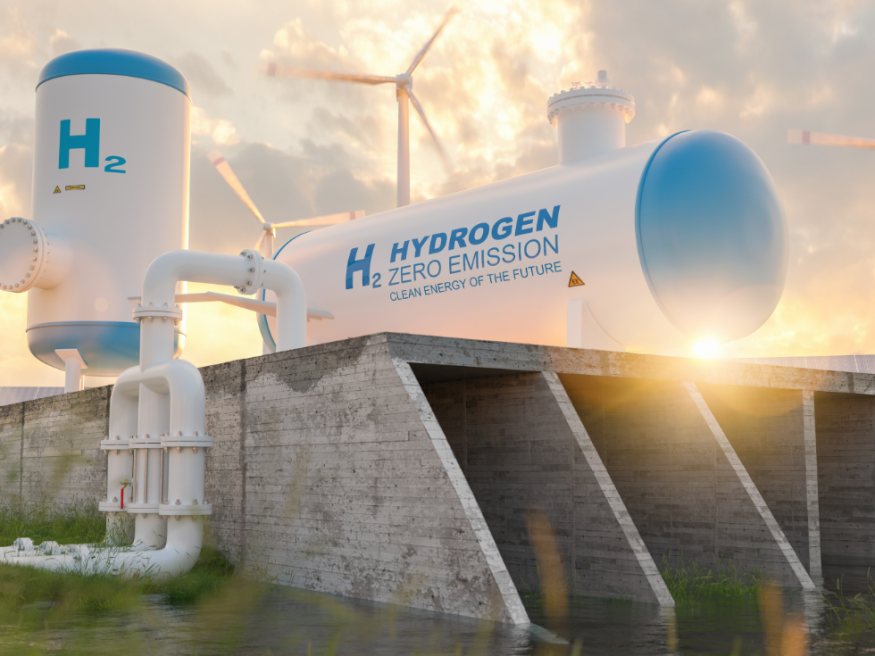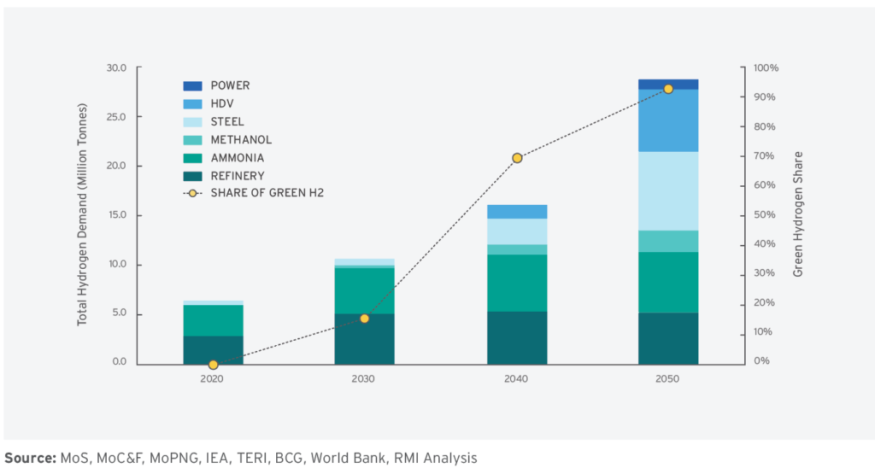
The Union Cabinet recently approved provisions of the National Green Hydrogen Mission and sanctioned INR 19,744 crore to implement the project. The mission aims to make India the global hub for the production of green hydrogen and achieve net-zero carbon emissions by 2070. With this mission, India joins the global race to develop a clean fuel for a green hydrogen economy.
What is the National Green Hydrogen Mission in India?
The 1Green Hydrogen Mission states that India will develop a Green Hydrogen production capacity of at least 5 million tonnes per annum and an additional 125 GW of renewable energy in the country by 2030. This will need over Rs 8 lakh crore of total investments and is expected to create more than six lakh jobs. It will also reduce fossil fuel imports by over Rs. 1 lakh crores and drop annual greenhouse gas emissions by about 50 MMT. 2The mission aims to develop India as an export hub for green hydrogen, specifically for the production of electrolyzers. Recently, Mukesh Ambani, chairman of Reliance Industries Ltd, estimated that renewable energy exports, including green hydrogen, from India could be as much as USD 500 billion in the next two decades. A thriving local production ecosystem will create a domestic market and drive exports, especially to countries such as Japan, South Korea, Singapore, and others. Companies investing in green energy will benefit if India grows as one of the global export hubs. According to a study by the Council on Energy, Environment and Water (CEEW), India can lead the energy transition to clean fuels with a green hydrogen economy that will help in reducing India's import dependency on hydrocarbon fuels, generate jobs that make the growth equitable, provide clean air to its citizens and reduce GHG emissions in absolute terms. Overall, the Green Hydrogen Mission is an excellent initiative toward sustainable development, ensuring energy security, cutting carbon emissions, and contributing to the country's overall economic growth.
How can India harness the power of green hydrogen?
Green Hydrogen is anticipated to revolutionize several applications of energy or feedstock sources and promote rapid decarbonization. -
3Hydrogen dominates oil refining, ammonia, methanol, and steel production. All this hydrogen is supplied from fossil fuels. So there is a significant possibility to reduce emissions from clean hydrogen.
In transportation, hydrogen fuel cell vehicles largely depend on fuel cell costs and refuelling stations, while trucks prioritise reducing the delivered price of hydrogen. Shipping and aviation have limited low-carbon fuel alternatives and represent an opportunity for hydrogen-based fuels.
Hydrogen is one of the emerging options for storing renewable energy in power generation. Hydrogen and ammonia can be used in gas turbines to increase power system flexibility and reduce emissions.

Global Hydrogen Supply and Demand:
Reaching the Net Zero scenario needs a change in demand creation, particularly in new applications. Providing hydrogen to industrial users is currently a significant business worldwide. 4Demand for hydrogen has increased more than triple since 1975 and continues to rise. Hydrogen demand can cultivate more than fourfold between 2020 and 2050, amounting to around 29 million tonnes by 2050. 5By 2030, hydrogen demand will reach about 180 Mt, and half of that demand coming from new applications, especially in heavy industry, power generation and the production of hydrogen-based fuels.
Green hydrogen investment in India:
The list of companies participating in the race for green hydrogen technology is long. 2Reliance Industries Ltd invested Rs 75,000 crore in renewable energy businesses, a significant chunk of which will be earmarked for manufacturing electrolyzers and hydrogen fuel cells. Larsen and Toubro Ltd joined with renewable energy producer ReNew Power to invest in the entire value chain of green hydrogen technology. Sajjan Jindal-led JSW Group also joined the bandwagon through a collaboration with Australia-based Fortescue Future Industries. The company plans to use green hydrogen technology to decarbonize its steel manufacturing operations. Similarly, public sector energy companies are also expected to play a significant part in green projects. For instance, state-run energy major IOC Ltd. has announced setting up the country's first dedicated plant for green hydrogen manufacturing in its Mathura-based refinery.
The Indian government has ambitious plans for the green hydrogen sector in 2023 and beyond. But its success will depend on a clear roadmap focusing on increasing investment and reducing production costs. 6RK Singh, the Union Minister for Power and Renewable energy, said on January 4 that the total budget is ₹19,744 crore, out of which ₹17,490 crore is allocated for the Strategic Interventions for Green Hydrogen Transition (SIGHT) programme. And ₹1,466 crores for the upcoming pilot projects, ₹400 crores for R&D, and ₹388 crores towards other mission components.

Hydrogen as a climate change solution:
Climate change is one of today's most critical issues, causing significant challenges to our communities and the environment. Fossil fuels contribute to climate change by releasing CO2 into the atmosphere, causing the planet to heat up and culminating in climate change. As a result, sea level rise, ice sheet and glacier shrinkage, destructive floods, and the consequences of climate change are global and unusual in scale. Acclimating to these effects in the future may be more complex and costly if significant action is not taken today. Green hydrogen is hydrogen fuel produced using renewable energy rather than fossil fuels. About 100 million tons of hydrogen are generated annually for various commercial applications. The vast majority of this industrial hydrogen is derived through coal gasification or steam methane reforming, both of which need a high level of strength and produce significant CO2 emissions. Water electrolysis has a significantly lesser percentage of hydrogen, which is a far more sustainable and clean approach if the energy is derived from renewable sources. A novel, green method of producing hydrogen could reduce global warming-causing greenhouse gas emissions and help countries achieve their zero-emission climate goals.
Conclusion:
India has an excellent opportunity to become a global leader in Green Hydrogen energy and increase investors' investment with proper policy support, industry effort, market generation and endorsement. India can set itself as a low-cost, zero-carbon manufacturing hub, fulfilling its goal of economic development, job creation, and improved public health.
FAQS
Who are the top players to watch ahead in green hydrogen production?
Reliance, Adani New Industries, Larsen and Toubro (L&T), JSW Energy, NTPC, and Indian Oil Corporation are amongst the leading green hydrogen manufacturers.
What are the challenges to making India a global hub of green hydrogen?
The significant challenges are the lack of transport and storage infrastructure, making green hydrogen production expensive.
Notes:
https://www.moneycontrol.com/news/business/economy/mcexplains-what-is-national-green-hydrogen-mission-and-what-is-indias-policy
https://www.ceew.in/blogs/ceew-explains-what-corporate-investments-mean-indias-green-hydrogen-export-manufacturing-market
https://www.iea.org/reports/the-future-of-hydrogen
https://impact.economist.com/sustainability/projects/the-future-of-hydrogen/driving-demand-for-hydrogen.html
https://www.niti.gov.in/sites/default/files/2022-06/Harnessing_Green_Hydrogen_V21_DIGITAL_29062022.pdf
https://www.downtoearth.org.in/news/renewable-energy/time-for-green-hydrogen-in-india-is-now-says-rk-singh-invites-private-players-to-invest-84856
© 2025 NatureWorldNews.com All rights reserved. Do not reproduce without permission.





